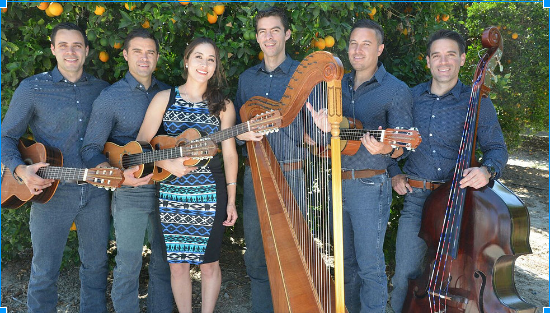FILLMORE — Hermanos Herrera, a six-member sibling group of third-generation Mexican Americans, makes its debut for Smithsonian Folkways Recordings with “Sones Jarochos y Huastecos y Más.”
The Herreras, raised in Fillmore, have performed together since childhood. Their music draws deeply from the lively, string-driven son jarocho and son huasteco traditions of Mexican music. The five brothers and one sister inherited their enthusiasm and talent for Mexican music from the previous generations of family members, who were active musicians. With ‘Sones Jarochos y Huastecos y Más,’ they’re set to write a fresh chapter in the music’s history and take it to new audiences.
Click here to order the CD.
Motivated by their family’s devotion to traditional music, Hermanos Herrera immersed themselves in a quarter century of mentorship by pillar performers of son huasteco and son jarocho, two favorite forms of Mexico’s rich musical heritage. They supercharged signature sounds with their own passion and an aggressive approach to playing the regional instruments of Veracruz: the harp, the five-string jarana guitar, and the distinctive requinto jarocho. In this album, they make their mark on musical gems popular on both sides of the Mexico-U.S. border.
“We like to show everybody what it means to be mexicano,” Jorge Andrés Herrera, the group’s oldest member, says in the album’s liner notes. “And son jarocho and son huastecodo that for us.”
Son jarocho, for the most part, is up-tempo music with an emphasis on improvisations. “La bamba,” popularized in the U.S. by Ritchie Valens and Los Lobos, draws from the son jarocho, and Hermanos Herrera includes their take on the traditional song on this album. The son huasteco, which historically has neighbored the son jarocho in northeastern Mexico, frequently features falsetto breaks in the singing, with accompaniment provided by violin, jarana guitar, and the deep-bodied huapanguera, which contributes the bass lines. The group brings their skillful musicianship and assertively rhythmic approach to examples of huapango, canciÓn ranchera, and cambia styles as well.
Smithsonian Folkways Recordings’ Curator Emeritus Dr. Daniel E. Sheehy produced ‘Sones Jarochos y Huastecos y Más.’ In the bilingual notes of the 40-page booklet that accompanies the 12-track album, Sheehy sets Hermanos Herrera in the context of both their family and the overall evolution of Mexican commercial music. “They never lose sight of the importance of family to their music, and of music to their family,” he says of the Herreras. “Jorge Andrés sums it up: ‘As long as we have music, we’re going to be close.'”
‘Sones Jarochos y Huastecos y Más’ Track List:
1. Popurri jarocho (Jarocho Medley)
2. La bamba
3. La morena (The Dark Woman)
4. A orillas del Papaloapan (At the Shores of the Papaloapan River)
5. El siquisiri
6. El Colás
7. Anoche estuve llorando (Last Night I Was Weeping)
8. El agujero (The Hole)
9. El gusto (The Pleasure)
10. El zacamandú
11. El San Lorenzo (Saint Lawrence)
12. La huasanga
About Smithsonian Folkways Recordings: Going into its 70th year, Smithsonian Folkways Recordings, the “National Museum of Sound,” makes available close to 60,000 tracks in physical and digital format as the nonprofit record label of the Smithsonian, with a reach of 80 million people per year. A division of the Smithsonian Center for Folklife and Cultural Heritage, the non-profit label is dedicated to supporting cultural diversity and increased understanding among people through the documentation, preservation, production and dissemination of sound. Its mission is the legacy of Moses Asch, who founded Folkways Records in 1948 to document “people’s music” from around the world. For more information about Smithsonian Folkways Recordings, visit folkways.si.edu

